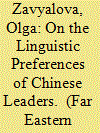| Srl | Item |
| 1 |
ID:
192510


|
|
|
|
|
| Summary/Abstract |
Chinese leaders have been attuned to language issues for centuries. In his speech at the 20th CPC Congress, Xi Jin-ping mentioned the continued promotion of the Putonghua official language and the standard Chinese character writing system as the main task of the country's language policy. Promoting traditional culture and preserving ancient written texts is another important task in modern China. It is no coincidence that soon after the 20th Congress, Xi Jinping visited excavations and a museum park at Yinxu, the site of the capital of the second period of the Shang-Yin Dynasty, where the most ancient jiaguwen Chinese inscriptions have been discovered. In the current period of revival of philological traditions, Xi Jinping's signature in his own calligraphic version with the traditional, non-simplified character 習 xí is widely used in Chinese propaganda. The importance of popularizing Chinese language and culture outside the country was discussed in a letter that Xi Jinping sent to a group of students from Saudi Arabia soon after the 20th Congress. As for the Hanyu Pinyin romanization system for Standard Mandarin Chinese, introduced in the PRC in 1958 - it is either positioned in official documents as an auxiliary means to be used in Chinese primary schools for writing Chinese words in foreign language texts and teaching Chinese to foreigners, or it is not mentioned at all.
|
|
|
|
|
|
|
|
|
|
|
|
|
|
|
|
| 2 |
ID:
166879


|
|
|
|
|
| Summary/Abstract |
Increasing numbers of Chinese and Japanese speakers have been reporting that their ability to handwrite Chinese characters has been steadily diminishing, a phenomenon which is most likely a result of the growing reliance upon digital technologies. This so-called “character amnesia” has recently attracted a great deal of concern from a large number of observers, especially within the People's Republic of China. Unsurprisingly, many of the concerned participants involved in the discourse on this issue tend to rely on various empirical means in order to illustrate why they consider “character amnesia” such a worrying phenomenon. This article argues, however, that the bulk of this empirical support is unreliable and/or invalid. The article also suggests possible amendments which could hopefully lead to a better understanding of this important subject.
|
|
|
|
|
|
|
|
|
|
|
|
|
|
|
|